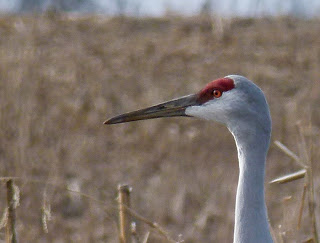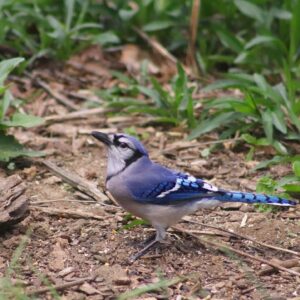One of the most exciting sounds in nature is the “kar-r-r-r- o-o-o” of Sandhill Cranes flying overhead in their spring and fall migration. We heard some today at Creasey Mahan Nature Preserve. Sandhill Cranes are large birds which have mostly grayish feathers– the shade of gray can vary widely. The forehead has a bright red patch that is one of the most noticeable features of the bird, while the cheeks are white. Sandhills fly with neck and legs extended.
Although the feathers are gray, sometimes they can have a reddish-brown appearance. Sandhill Cranes preen themselves by rubbing mud on their feathers. The mud can be brown or red, and comes from iron rich environments, producing the reddish tinge. As the cranes molt the red will disappear.
Sandhill Cranes are opportunistic feeders and change their diet based on what is available. They most often eat plants and grains, but also dine on invertebrates or even small mammals, amphibians and reptiles. If you are searching for them, look primarily in fields of corn stubble, rather than soybean fields.
Three subpopulations of Sandhill Cranes are migratory. The Lesser, Greater and Canadian Sandhill Cranes spend winters in the south and summers at their breeding grounds. Sandhill cranes winter in Texas, California, Arizona, New Mexico and Mexico. In the early spring, the cranes begin the migration to their breeding grounds. Throughout the spring, the cranes can be seen resting and feeding along rivers and wetlands throughout the Great Plains and Pacific Northwest. The largest congregation of Sandhill Cranes occurs from February to early April along the Platte River in Nebraska. During the late spring, summer and early fall, Sandhill Cranes can be seen at their breeding grounds, in Minnesota, Wisconsin and Michigan. Others breed in Oregon, Idaho and Alaska. Although the majority of migration routes are in the Plains states, one route passes right over Kentucky. Major stopovers for these cranes are in northern Indiana (More than 10,000 sandhill cranes stop during fall migration at Jasper-Pulaski Wildife Area.) and eastern Tennessee (Hiwassee Refuge).
In the early spring, as Sandhill Cranes are migrating to their breeding grounds, single cranes will start pairing up. A Sandhill Crane pair performs unison calling to create a bond. When the pair reaches the northern breeding grounds, they mate and build a nest. During mating, Sandhill Cranes perform dancing displays. Although the dancing is most common in the breeding season, the cranes can dance all year long. Sometimes the dance involves wing flapping, bowing, jumps and simply playing around. They might also throw a stick or some plants into the air.
Sandhill Cranes have an interesting and distinctive call. Both the males and females make a rattling “kar-r-r-r- o-o-o” sound. The call varies in length, strength and loudness depending on its intention. The loudest and most noticeable call is during the mating season. Males and females will sing loudly and in unison. You can hear them calling high above even though you can’t see them.
Habitat loss—due to destruction, fragmentation or degradation of habitat—is the primary threat to the survival of wildlife in the United States. When an ecosystem has been dramatically changed by human activities—such as agriculture, oil and gas exploration, commercial development or water diversion—it may no longer be able to provide the food, water, cover, and places to raise young. Every day there are fewer places left that wildlife can call home. The endangered Whooping Crane sometimes travels with a flock of Sandhills, but the are larger and white in color.









